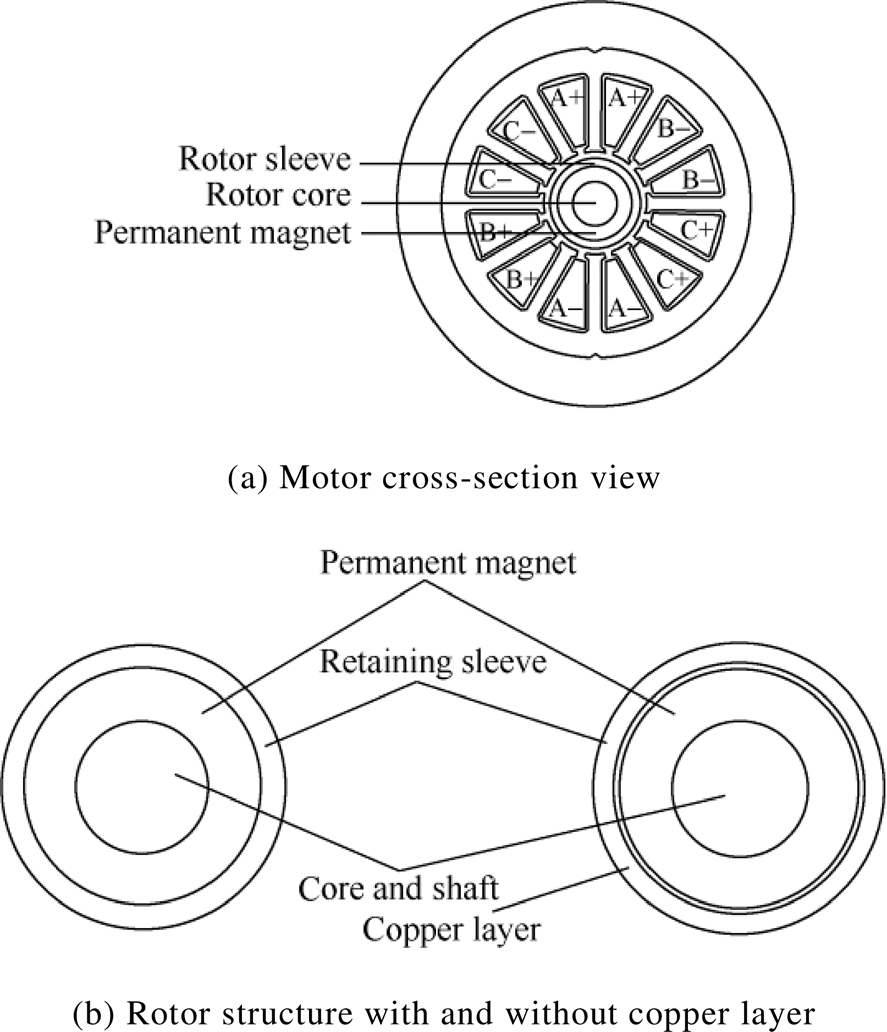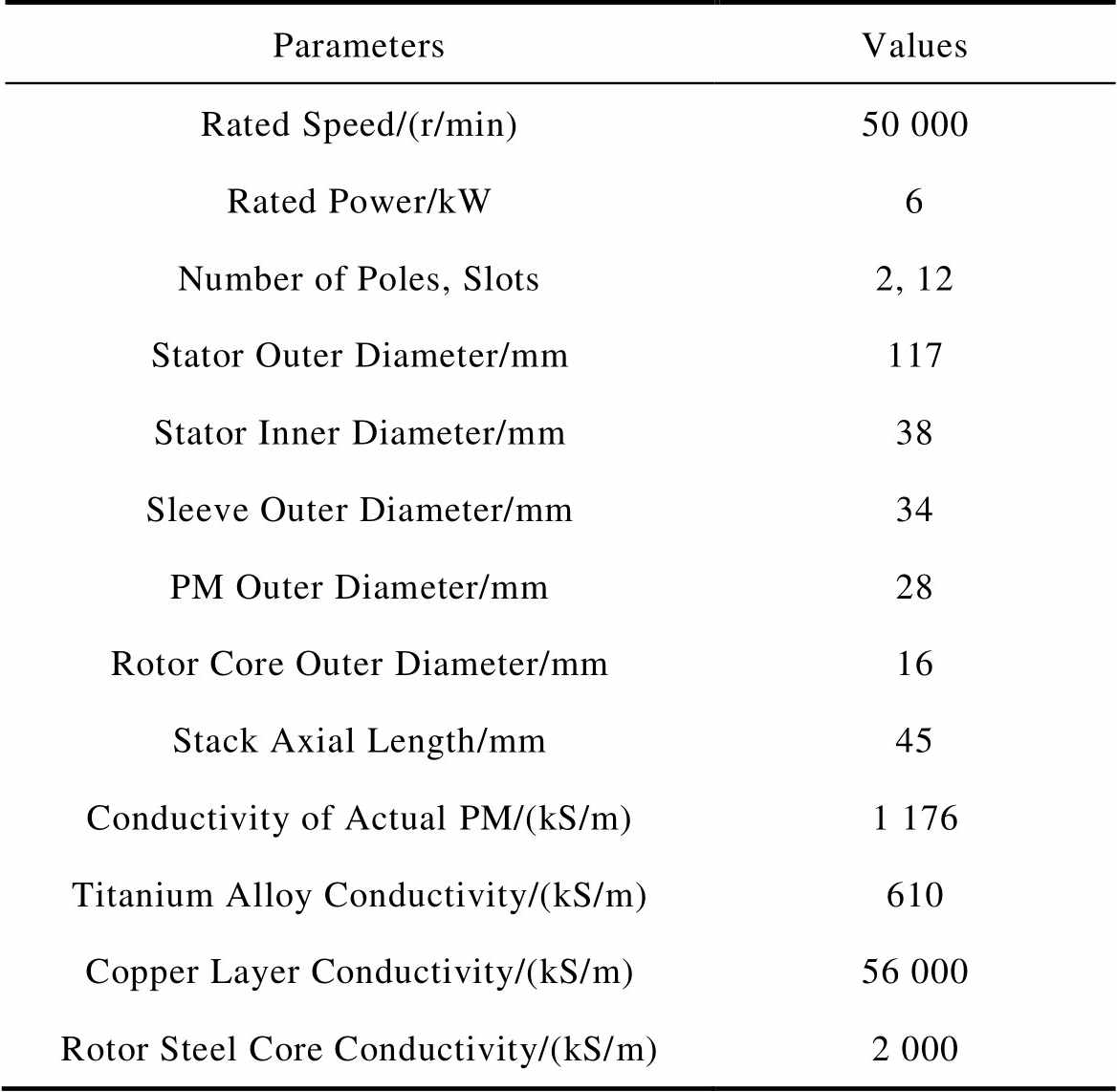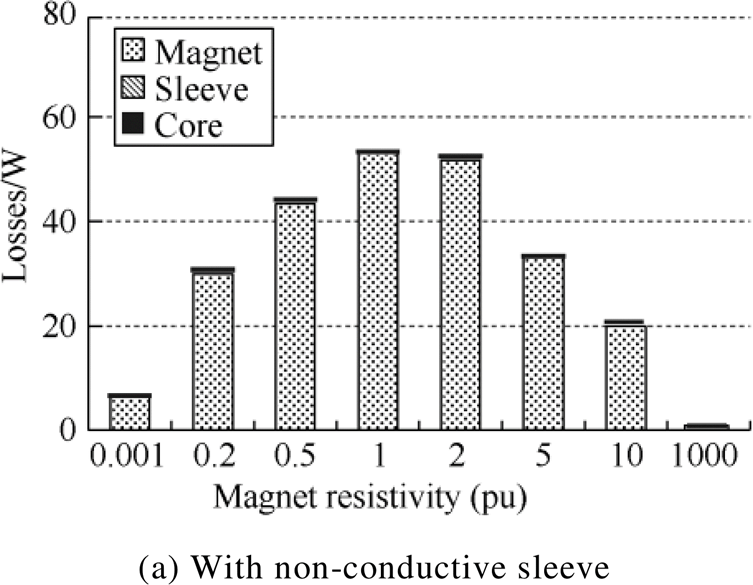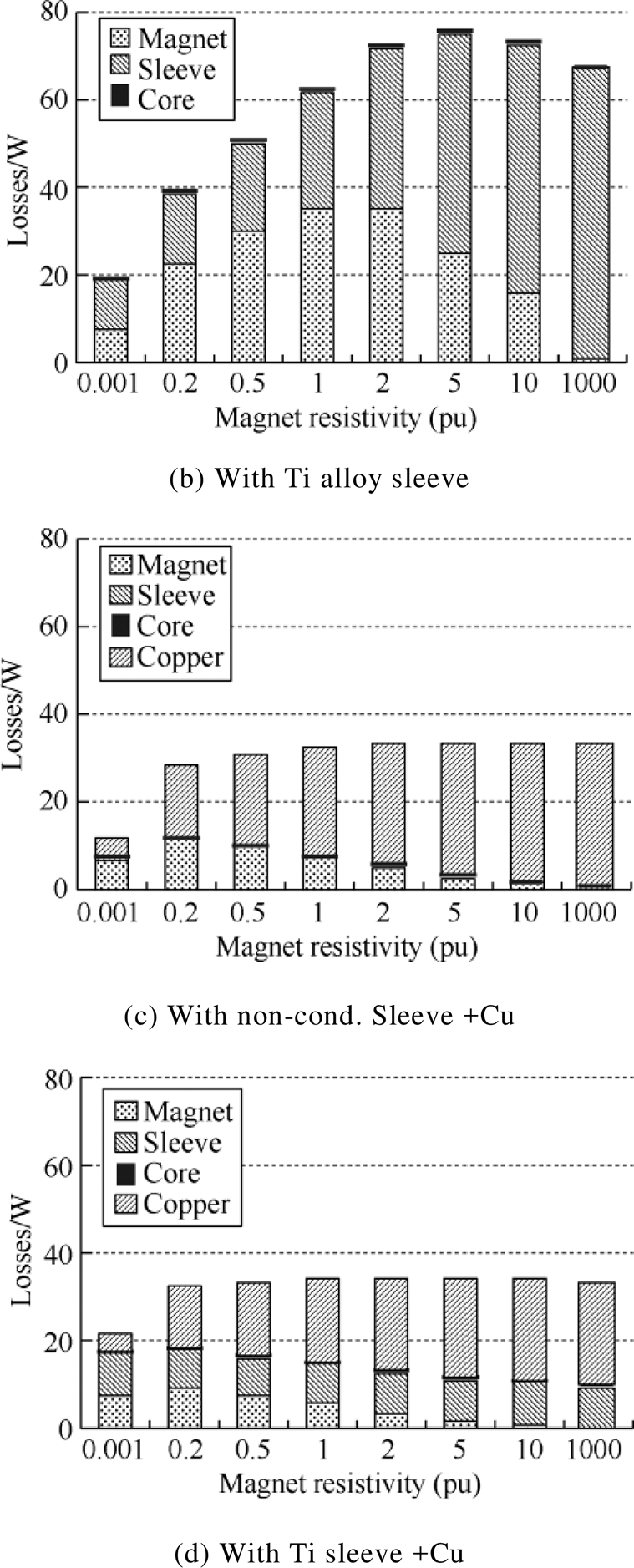
Fig.1 Studied motor with different rotor structures
Abstract When permanent magnets (PM) are exposed to harmonic fields, eddy current exists if the magnets are electrically conductive, causing power loss. Increasing the magnet resistivity is a direct way to reduce the eddy current in the magnets. However, in high-speed PM AC machines, eddy current occurs not only in the magnets, but also in the metal retaining sleeve and the copper shielding layer of the rotor. Under such a circumstance, is the technique of increasing the magnet resistivity still workable? This will be answered in this article, through a comparative finite element analysis.
Keywords: High-speed machine, permanent magnets (PM) AC machine, rotor eddy current loss, magnet resistivity, retaining sleeve, copper shielding layer
Although the rotor of permanent magnet (PM) AC machine (viz., brushless DC (BLDC) machine or synchronous machine (PMSM)) rotates at the synchronous speed of the armature field, it contains more or less eddy current because of the harmonic fields, which are caused by the armature current time harmonics, stator magnetomotive force (MMF) spatial harmonics, and airgap permeance variation due to stator core slot openings[1-3], etc. The eddy current mainly exists in the permanent magnets if they are mounted on the rotor surface. To reduce the eddy current, a common way is to segment the magnets, with insulation between the magnet pieces[4]. In this case, the overall equivalent resistivity of the magnets is enlarged. The other way is to directly increase the magnet resistivity by changing the material com- position[5-6], which is usually difficult to realize and may even deteriorate the magnetic performance of the magnets. Furthermore, it is understandable that if the magnet resistivity becomes very large, such as the case of the ferrite magnets, the eddy current will become negligible[7].
High-speed PM AC machines have been widely used for various applications[8-10]. In this kind of machines the harmonic fields have higher frequency than those in the regular-speed machines, hence, the rotor eddy current is severer, and must be critically reduced.
Moreover, a retaining sleeve is usually employed to protect the high-speed machine rotor, especially when the magnets are surface-mounted. Thus, eddy current also exists in the retaining sleeve if it is electrically conductive. Similar to the magnet segmenting technique, the sleeve can be laminated or surface-grooved[7, 11], in order to increase the equivalent resistivity of the retaining sleeve. Of course non-metal retaining sleeve can be used for eliminating its eddy current, but usually it has a low thermal conductivity which is bad for heat dissipation from the inner magnets.
On the other hand, it is proposed that a thin copper layer can be placed between the retaining sleeve and the magnets[12]. The copper layer contains eddy current, which in turn cancels the harmonic fields so that the eddy current in the retaining sleeve and the magnets are largely reduced. Meanwhile, the copper layer has a high electric conductivity, hence its eddy current just makes a very low power loss. Clearly, here, the magnetic shielding effect of the copper layer is utilized, hence the total rotor eddy current loss is reduced. This method is even more effective than those of increasing the equivalent resistivity of the magnets or retaining sleeve[7]. It is also understandable that if the rotor material resistivity is extremely low, the rotor eddy current loss will be negligible, too, although the eddy current itself does exist.
The technique of directly increasing the electric resistivity of the sintered rare-earth permanent magnets helps to reduce the eddy current and the consequent power loss in the magnets. However, in the high-speed PM AC machines, eddy current also exists in the metal retaining sleeve and even in the copper shielding layer. Therefore, it is questionable whether this technique is workable for reducing the total rotor eddy current loss. And, this will be analyzed hereafter, through a comparative finite element analysis (FEA).
A 50kr/min 6kW PM BLDC motor, as shown in Fig.1, is taken as an example in the analysis. It uses surface-mounted magnets on the rotor, which are protected by either non-conductive retaining sleeve or titanium alloy sleeve. A copper shielding layer may be placed between the sleeve and magnets. Therefore, there are four rotor structures in total, i.e., those with the non-conductive sleeve only, titanium sleeve only, non-conductive sleeve plus copper layer, and, titanium sleeve plus copper layer. The design parameters are listed in Tab.1.

Fig.1 Studied motor with different rotor structures
Tab.1 Parameters of high-speed PM BLDC motor

ParametersValues Rated Speed/(r/min)50 000 Rated Power/kW6 Number of Poles, Slots2, 12 Stator Outer Diameter/mm117 Stator Inner Diameter/mm38 Sleeve Outer Diameter/mm34 PM Outer Diameter/mm28 Rotor Core Outer Diameter/mm16 Stack Axial Length/mm45 Conductivity of Actual PM/(kS/m)1 176 Titanium Alloy Conductivity/(kS/m)610 Copper Layer Conductivity/(kS/m)56 000 Rotor Steel Core Conductivity/(kS/m)2 000
Under the rated operation condition, the current of each phase winding is shown in Fig.2, containing time harmonics.

Fig.2 Rated current of studied motor
In order to investigate the influence of PM resistivity on the total rotor eddy current loss, it is assumed that the resistivity could be changed as much as wanted, but the PM magnetic property is not affected. The total rotor eddy current loss is then calculated with the FEA models, and the results are shown in Fig.3, where the magnet resistivity is expressed in per unit (pu) whilst the reference value is the actual resistivity of a sintered Sm2Co17 product (being 8.503´10-7W∙m). In Fig.3, the eddy current loss in the rotor core is given, but this part is too small to view, thus, it is no more mentioned hereafter.
As shown in Fig.3a, if only the non-conductive retaining sleeve is employed, the rotor eddy current just exists in the magnets. Then, as pointed out in early literatures[5-6], the eddy current loss can be reduced by directly increasing the magnet resistivity. However, if the resistivity could be dramatically lowered, the magnet would exhibit the magnetic shielding effect, too, hence the eddy current loss would also decrease. Nevertheless, it is difficult to change the magnet resistivity significantly. Therefore, in practice, slightly reducing the magnet resistivity may be even more beneficial than increasing the resistivity in order to reduce the eddy current loss.


Fig.3 PM resistivity with rotor eddy current loss.
Fig.3b shows that if the conductive titanium retaining sleeve is employed, eddy current exists in both the sleeve and magnets. The total loss becomes larger than that of Fig.3a, but the loss in the magnets reduces due to the magnetic shielding effect of the sleeve. In fact, both the sleeve and the magnets have, more or less, the magnetic shielding effect, as they contain eddy current. However, it is noticed that the total rotor eddy current loss can become even worse if the magnet resistivity increases, as the overall shielding effect declines.
Fig.3c and Fig.3d show that if a copper layer is used, its magnetic shielding effect can largely reduce the total rotor eddy current loss, no matter what kind of retaining sleeve is applied. This coincides with the analysis in Ref.[12]. However, the magnet resistivity has little influence on the value of total rotor eddy current loss, but affects the loss distribution in different parts of the rotor. Considering the heat dissipation path from the rotor to the airgap, theoretically, it is better to distribute the loss more in the outer part of the rotor. Nevertheless, due to the rather high thermal conductivity of the copper layer, the loss distribution difference has little thermal influence, either.
In general, if the magnet resistivity can be adjusted over the range between 0.5(pu) and 2(pu) as a practical situation, for the studied high-speed PM BLDC motor, increasing the resistivity does not seem to be beneficial to reduce the total rotor eddy current loss.
As material scientists have found, increasing the magnet resistivity is a functional technique to reduce the eddy current and the consequent loss in the magnets. However, in high-speed PM AC machines, the rotor structure is usually complicated, the eddy current may exist in some other parts of the rotor, and each part with eddy current has the magnetic shielding effect. Therefore, it has been revealed in this article that increasing the magnet resistivity is not certainly workable, since the shielding effect of the magnets declines. In some cases, this may even enlarge the total rotor eddy current loss. Instead, it is worth investigating the design with a lower overall equivalent resistivity of the rotor materials.
Reference:
[1] Sun Quangui, Deng Zhiquan, Zhang Zhongming. Analytical calculation of rotor eddy current losses in high speed permanent magnet machines accounting for influence of slot opening[J]. Transactions of China Electrotechnical Society, 2018, 33(9): 1994-2004.
[2] Wang Tianyu, Wen Fuqiang, Zhang Fengge, et al. Analysis of multi-field coupling strength for MW high-speed permanent magnet machine[J]. Transa- ctions of China Electrotechnical Society, 2018, 33(19): 4058-4516.
[3] Zeng Yingyu,Jiang Xiaohua. A similarity method based on spectrum compression for calculating eddy current loss in magnets of PM machines fed by PWM voltage[J]. Transactions of China Electrotechnical Society, 2018, 33(2): 943-954.
[4] Katsumi Y, Yu F. Effect of eddy-current loss reduction by magnet segmentation in synchronous motors with concentrated windings[C]//2009 Inter- national Conference on Electrical Machines and Systems, Tokyo, 2009: 1-6.
[5] Chins C, Melania M J, Daniel P, et al. High electrical resistivity Sm (Co,Fe,Cu,Zr)z/Sm2S3 permanent magnets with layered structure for advanced motors[J]. IEEE Transactions on Magnetics, 2012, 48(11): 3166-3169.
[6] Matahiro K, Yuichi S, Yuji E. Enomoto, et al. High electrical resistance hot-pressed NdFeB magnet for low loss motors[J]. Applied Physics Letters, 2007, 91(10): 102503-102503-3.
[7] Han Ting, Wang Yunchong, Qin Xuefei, et al. Investi- gation of various rotor retaining sleeve structures in high-speed PM brushless motors[C]//2018 Inter- national Conference on Electrical Machines and Systems, Jeju, 2018: 1-6.
[8] Masayuki M, Kenichi A, Takao S, et al. Position sensorless starting of super high-speed PM generator for micro gas turbines[J]. IEEE Transactions on Industrial Electronics, 2006, 53(2): 415-420.
[9] Chen Jiaxin, Guo Youguang, Zhu Jianguo. Deve- lopment of a high-speed permanent-magnet brushless DC motor for driving embroidery machines[J]. IEEE Transactions on Magnetics, 2007, 43(11): 4004-4009.
[10] Jang S M, Cho H W, Choi S K. Design and analysis of a high-speed brushless DC motor for centrifugal compressor[J]. IEEE Transactions on Magnetics, 2007, 43(6): 2573-2575.
[11] Shen J X, Hao H, Yuan C. FEA study on circum- ferential grooves on rotor retaining sleeve of high- speed PM brushless motors[J]. IEEE Transactions on Magnetics, 2012, 32(36): 53-60.
[12] Zhou Fengzheng, Shen Jianxin, Fei Weizhong. Study of retaining sleeve and conductive shield and their influence on rotor loss in high-speed PM BLDC motors[J]. IEEE Transactions on Magnetics, 2006, 42(10): 3398-3400.
提高永磁体电阻率对降低高速永磁交流电机转子涡流损耗的有效性分析
摘要 导电的永磁体暴露于谐波磁场时,会产生涡流及损耗。提高永磁体的电阻率是减小其涡流的最直接方法。但是,在高速永磁交流电机中,涡流不仅存在于永磁体中,也存在于转子的金属保护套及铜屏蔽层中。在此条件下,提高永磁体的电阻率是否仍然有效?本文将通过有限元分析与对比研究,来探讨这个问题。
关键词:高速电机 永磁交流电机 转子涡流损耗 永磁体电阻率 保护套 铜屏蔽层
中图分类号: TM315
DOI: 10.19595/j.cnki.1000-6753.tces.200255
Received March 12, 2020;
Revised April 2,2020.
This work was supported by the Natural Science Foundation of China under the grants of 51837010 and 51690182.
Shen Jianxin born in 1969, professor. His main research interests include design, control and applications of PM machines, SynRM, high speed machines, and high efficiency motor drives.E-mail: J_X_Shen@zju.edu.cn
Wang Yunchong born in 1987, associate professor. His main research interests include design and control of high speed machines, PM machines and SynRM.E-mail: wangycee@zju.edu.cn (Corresponding author)
(编辑 郭丽军)